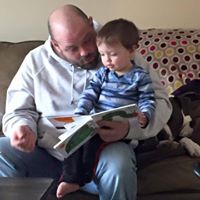John J Koza
age ~77
from Pensacola, FL
- Also known as:
-
- Koza J Koza
John Koza Phones & Addresses
- Pensacola, FL
- Grant, MI
- 35 Hampshire Dr, Cheshire, MA 01225 • 413 743-7673 • 413 743-9289
- San Jose, CA
- Adams, MA
- 35 Hampshire Dr, Cheshire, MA 01225 • 413 743-9289
Work
-
Position:Transportation and Material Moving Occupations
Education
-
Degree:Associate degree or higher
Wikipedia References

John Koza
Work:
Company:
Stanford University School of Engineering faculty
Area of science:Computer scientist
Business category:Lenses
Education:
Studied at:
University of Michigan
Academic degree:Professor
Skills & Activities:
Skill:
Computer science
Military rank:Specialist
Name / Title
Company / Classification
Phones & Addresses
Owner
Koza's Small Engine Repair
Small Enginee
Small Enginee
35 Hampshire Dr, Cheshire, MA 01225
413 743-9289
413 743-9289
President
Genetic Programing Inc
Noncommercial Research Organization
Noncommercial Research Organization
Po Box K, Los Altos, CA 94023
Los Altos, CA 94023
Los Altos, CA 94023
President
GENETIC PROGRAMMING INC
Los Altos, CA 94023
President
THIRD MILLENNIUM ON-LINE PRODUCTS INC
Internet Entertainment Product
Internet Entertainment Product
Los Altos, CA 94023
650 941-0336
650 941-0336
President, Secretary, Treasurer, President
THIRD MILLENNIUM VENTURE CAPITAL LIMITED
Box 112 BOX 1123, Los Altos, CA 94023
PO Box 1123, Los Altos, CA 94023
PO Box 1123, Los Altos, CA 94023
Us Patents
-
Method And Apparatus For Automated Design Of Complex Structures Using Genetic Programming
view source -
US Patent:6360191, Mar 19, 2002
-
Filed:Jan 5, 1999
-
Appl. No.:09/225643
-
Inventors:John R. Koza - Los Altos Hills CA 94022
David Andre - Menlo Park CA
Martin A. Keane - Chicago IL -
Assignee:John R. Koza - Los Altos Hills CA
-
International Classification:G06G 748
-
US Classification:703 6, 703 2, 703 7, 703 14, 703 22, 716 1, 716 2
-
Abstract:An automated design process and apparatus for use in designing complex structures, such as circuits, to satisfy prespecified design goals, using genetic operations. The present invention uses a population of entities which may be evolved to generate structures that may potentially satisfy the design goals. The behavior of such generated structures is evaluated in view of the design goals, and those structures more closely meeting the design goals are evolved further until a structure is generated that either meets the prespecified design goal or some other process completion criteria. In this manner, a design complex structure may be obtained.
-
Method And Apparatus For Automatic Synthesis, Placement And Routing Of Complex Structures
view source -
US Patent:6424959, Jul 23, 2002
-
Filed:Jun 17, 1999
-
Appl. No.:09/336373
-
Inventors:John R. Koza - Los Altos Hills CA 94022
-
Assignee:John R. Koza - Los Altos Hills CA
-
International Classification:G06F 9445
-
US Classification:706 13, 706919, 706921, 714 8, 714724, 716 8
-
Abstract:The present invention consists of a method and apparatus for the automatic creation of the topology, component sizing, placement, and routing of complex structures, such as electronic circuits or mechanical systems, to satisfy prespecified high-level design goals. The present invention uses a population of entities which are evolved over a series of generations by an iterative process involving the application of operations, such as mutation, crossover, reproduction, and architecture-altering operations. The individuals in the population are each developed, in a developmental process, into a structure that may potentially satisfy the design goals. The present invention also determines the placement of components within the developing structure and determining the routing of the connecting means (wires for electrical circuits) between the components. The behavior of the structures is evaluated in relation to the high-level design goals, and those structures more closely satisfying the design goals are evolved further until a structure is generated that either meets the prespecified design goal. In this manner, the topology, component sizing, placement, and routing of a complex structure may be obtained.
-
Genetic Programming Problem Solver With Automatically Defined Stores Loops And Recursions
view source -
US Patent:6532453, Mar 11, 2003
-
Filed:Apr 12, 1999
-
Appl. No.:09/290521
-
Inventors:John R. Koza - Los Altos Hills CA 94022
David Andre - Menlo Park CA
Martin A. Keane - Chicago IL -
Assignee:John R. Koza - Los Alto Hills CA
-
International Classification:G06F 1518
-
US Classification:706 13
-
Abstract:The present invention is a genetic programming problem solver that automatically generates computer programs to solve problems. The genetic programming problem solver incorporates architecture-altering operations. In one embodiment, the genetic programming problem solver uses architecture-altering operations for automatically defined functions and loops, together with indexed memory, to generate the resulting computer programs. In a second embodiment, the genetic programming problem solver uses architecture-altering operations of automatically defined function, loops, recursions, and stores to generate the resulting computer programs.
-
Method And Apparatus For Automatic Synthesis Controllers
view source -
US Patent:6564194, May 13, 2003
-
Filed:Sep 10, 1999
-
Appl. No.:09/393863
-
Inventors:John R. Koza - Los Altos Hills CA 94022
Martin A. Keane - Chicago IL
Jessen Yu - Sunnyvale CA
William Mydlowec - Sunnyvale CA -
Assignee:John R. Koza - Los Altos Hills CA
-
International Classification:G06N 312
-
US Classification:706 13, 706 52, 364472, 364476
-
Abstract:A general automated method for synthesizing the design of both the topology and parameter values for controllers is described. The automated method automatically makes decisions concerning the total number of signal processing blocks to be employed in the controller, the type of each signal processing block, the topological interconnections between the signal processing blocks, the values of all parameters for the signal processing blocks, and the existence, if any, of internal feedback between the signal processing blocks within the controller. The general automated method can simultaneously optimize prespecified performance metrics (such as minimizing the time required to bring the plant outputs to the desired values as measured by the integral of the time-weighted absolute error or the integral of the squared error), satisfy time-domain constraints (such as overshoot, disturbance rejection, limits on control variables, and limits on state variables), and satisfy frequency domain constraints (bandwidth).
-
Skill Games
view source -
US Patent:6767284, Jul 27, 2004
-
Filed:Mar 14, 2000
-
Appl. No.:09/524857
-
Inventors:John R. Koza - Los Altos Hills CA 94022
-
Assignee:John R. Koza - Los Altos CA
-
International Classification:A63F 924
-
US Classification:463 29, 463 42
-
Abstract:Skill games are described that are implemented using network communications. The subject matter of the present invention concerns games of skill that are legal, under current law, in most states of the United States and in many jurisdictions of other countries and the game includes a mechanism for determining if a player is eligible.
-
Skill Games
view source -
US Patent:6964608, Nov 15, 2005
-
Filed:Oct 17, 2000
-
Appl. No.:09/690923
-
Inventors:John R. Koza - Los Altos Hills CA, US
-
International Classification:A63F009/24
-
US Classification:463 9, 379 9313, 340323 R, 700 92
-
Abstract:Skill games are described that are implemented using network communications. The subject matter of the present invention concerns games of skill that are legal, under current law, in most states of the United States and in many jurisdictions of other countries and the game includes a mechanism for determining if a player is eligible.
-
Method And Apparatus For Automatic Synthesis Of Controllers
view source -
US Patent:7117186, Oct 3, 2006
-
Filed:Jan 30, 2003
-
Appl. No.:10/355443
-
Inventors:John R. Koza - Los Altos Hills CA, US
Martin A. Keane - Chicago IL, US
Jessen Yu - Sunnyvale CA, US
William Mydlowec - Sunnyvale CA, US -
International Classification:G08N 5/00
-
US Classification:706 13, 706 45
-
Abstract:A general automated method for synthesizing the design of both the topology and parameter values for controllers is described. The automated method automatically makes decisions concerning the total number of signal processing blocks to be employed in the controller, the type of each signal processing block, the topological interconnections between the signal processing blocks, the values of all parameters for the signal processing blocks, and the existence, if any, of internal feedback between the signal processing blocks within the controller. The general automated method can simultaneously optimize prespecified performance metrics (such as minimizing the time required to bring the plant outputs to the desired values as measured by the integral of the time-weighted absolute error or the integral of the squared error), satisfy time-domain constraints (such as overshoot, disturbance rejection, limits on control variables, and limits on state variables), and satisfy frequency domain constraints (bandwidth).
-
Method And Apparatus For Designing Structures
view source -
US Patent:8356000, Jan 15, 2013
-
Filed:Apr 13, 2000
-
Appl. No.:09/548637
-
Inventors:John R. Koza - Los Altos Hills CA, US
Oscar Stiffelman - Seattle WA, US -
International Classification:G06N 3/12
-
US Classification:706 13
-
Abstract:A method and apparatus for the automatic creation of novel designs, specifically electronic circuits, controllers, antennas, and mechanical systems to satisfy prespecified design goals, using search procedures, such as genetic programming, genetic algorithms, simulated annealing and hill climbing is described. Further, the techniques include automatically creates designs which do not posses key characteristics of preexisting technology. The present invention uses a population of entities which may be evolved to generate structures that may potentially satisfy the design goals. The behavior of the structures is evaluated in view of the design goals, and the structures are compared to a preexisting structure. Those structures more closely meeting the design goals and not similar to the preexisting structure are favored further until a structure is generated that either meets the prespecified design goal or some other process completion criteria. In this manner, a novel structure may be obtained.
Isbn (Books And Publications)
-
Genetic Programming: On The Programming Of Computers By Means Of Natural Selection
view source -
Author:John R. Koza
-
ISBN #:0262111705
-
Genetic Programming Ii : Automatic Discovery Of Reusable Programs
view source -
Author:John R. Koza
-
ISBN #:0262111896
-
Genetic Programming 1996: Proceedings Of The First Annual Conference, July 28-31, 1996, Stanford University
view source -
Author:John R. Koza
-
ISBN #:0262611279
Plaxo

John Koza
view sourceGeneral Physics
Myspace
Classmates

John Koza
view sourceSchools:
Sewell - Anderson Elementary School Lynn MA 1983-1989
Community:
Sandra Blakley, Marguerite Fayles, Ralph Gregorio, Steven Mitchell

John Koza
view sourceSchools:
Pearland High School Pearland TX 1988-1992

John Koza, Live Oak High ...
view source
Frank Huff Elementary Sch...
view sourceGraduates:
Cyndie Roberts (1966-1969),
John Koza (1974-1976),
Andrea Fabbrini (1971-1978),
Garrett Person (1969-1976)
John Koza (1974-1976),
Andrea Fabbrini (1971-1978),
Garrett Person (1969-1976)

O.J. Cooper Elementary Sc...
view sourceGraduates:
John Koza (1973-1973),
Derek Person (1973-1976)
Derek Person (1973-1976)

Green Middle School, Gree...
view sourceGraduates:
Rosemary Caravito (1981-1982),
Sherri Sisler (1995-1999),
Julie Bathori (1969-1971),
John Koza (1995-1999)
Sherri Sisler (1995-1999),
Julie Bathori (1969-1971),
John Koza (1995-1999)

Britton Middle School, Mo...
view sourceGraduates:
John Koza (1977-1978),
Doeri Welch (1973-1974),
Becky McCune (1982-1984),
Brandy Schneider (1990-1993),
Kassene Anderson (1979-1981),
John Georges (1976-1978)
Doeri Welch (1973-1974),
Becky McCune (1982-1984),
Brandy Schneider (1990-1993),
Kassene Anderson (1979-1981),
John Georges (1976-1978)
Googleplus

John Koza

John Koza

John Koza

John Koza
view source
John Koza
view source
John Koza
view source
John Koza
view source
John Koza
view source
John F. Koza
view source
John Koza
view source
John Koza
view sourceYoutube
News

Majority revolt: Post-election, California-set movements aim to change voting system—or escape it
view source- The compact could work, in part, because a state solution would appeal to constitutionally conservative legislators across the aisle, said John Koza, the National Popular Vote movement chairman. Their work remains in lobbying outside of California, in redder and unpledged blue states, he said. Its
- Date: Jan 19, 2017
- Category: U.S.
- Source: Google

In 1969, Democrats and Republicans united to get rid of the electoral college. Here's what happened
view source- In 2006, John Koza, a computer scientist, penned a proposal creating the National Popular Vote Interstate Compact an effort in which states agree to award all their electoral votes to the winner of the national popular vote.So far, 10 states and the District of Columbia have signed up, including
- Date: Dec 19, 2016
- Category: U.S.
- Source: Google

The electoral college has serious problems. So do any alternatives.
view source- ectors. NPV is an interstate compact that would require states to have their electors vote for the winner of the national popular vote, no matter who wins their own state. (For much more detail on the NPV, see the exchange between John Koza and DeWitt and Schwartz in the issue of PSmentioned above.)
- Date: Nov 15, 2016
- Category: World
- Source: Google

Three common arguments for preserving the Electoral College – and why they're wrong
view source- amending the Constitution is a plan called the National Popular Vote Interstate Compact. Created by Stanford University computer science professor John Koza, the idea is to award each states electoral votes to the winner of the national popular vote instead of the winner of the state popular vote. T
- Date: Nov 14, 2016
- Category: Health
- Source: Google

Millions Sign Onto Call for Electoral College to Award the Presidency to Popular Vote Winner Clinton
view source- still lost the election to George W. Bush. Well, for more, were going to Stanford, California, where were joined by John Koza, chair of National Popular Vote, consulting professor at Stanford University in computer science and electrical engineering. Koza is the former CEO of Scientific Games. Wel
- Date: Nov 13, 2016
- Source: Google

Obama wins Electoral College vote; Republicans seek changes in state rules
view source- states and the District of Columbia have enacted such legislation. Those states, which include California, are Democratic states, a result that John Koza, a former Stanford University professor who is chairman of National Popular Vote, attributes to Democrats displeasure with Gores 2000 loss.
- Date: Dec 17, 2012
- Source: Google

Time to eliminate the Electoral College?
view source- "The current system has the problem that presidential campaigns concentrate on only 10 of the 50 states, and at least four out of five Americans are left out of the process of deciding who their president should be," argued John Koza, who leads an effort to eliminate the Electoral College.
- Date: Nov 05, 2012
- Source: Google
Get Report for John J Koza from Pensacola, FL, age ~77





